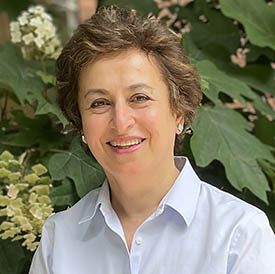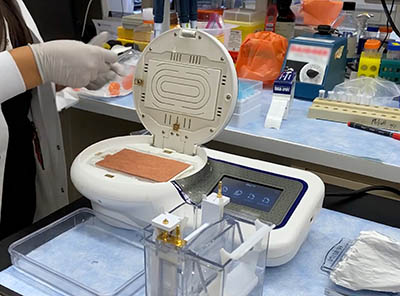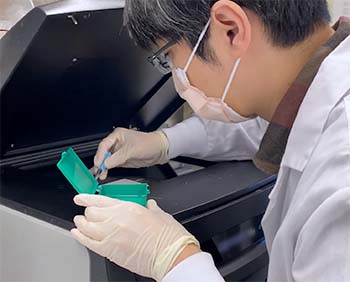News You Can Use: Green Labs
In NIDDK Labs, It IS Easy Being Green
NIDDK Focuses on Environmental Sustainability
At the National Institute of Diabetes and Digestive and Kidney Diseases (NIDDK), even small changes made lab by lab are making a big impact in environmental sustainability in the scientific workplace. In NIH-certified Green Labs in NIDDK, changes prompted by a desire to improve the environment and human health have ended up saving energy, space, and even money in the process.
In one “green” example, the Genetics and Metabolism Section of NIDDK’s Liver Diseases Branch traded in traditional X-ray imaging for digital-imaging systems, eliminating the need for costly X-ray films and hazardous waste, and freeing up laboratory space previously used for dark rooms and film equipment. This change led to a savings of more than $11,000 in one year alone.

CREDIT: NIDDK
NIDDK Technical Lab Manager Minoo Shakoury-Elizeh is one of the pioneers who started the NIH green labs movement.
“Improving environmental practices in the lab doesn’t require drastic changes,” said Minoo Shakoury-Elizeh, a recipient of the FY2020 Health and Human Services (HHS) Green Champion Award and a technical lab manager in NIDDK’s Laboratory of Cellular and Developmental Biology (which has also won several HHS Green Champion awards). “Small changes add up, leading to improved conservation of energy and water, less waste, and safer, more effective lab practices.”
NIDDK has been at the forefront of the NIH’s green lab movement. Its Genetics and Metabolism Section is where iron and its role in diseases within NIDDK’s mission are studied. It’s also where Shakoury-Elizeh championed sustainability efforts as one of NIDDK’s four NIH-certified green labs, following practices like replacing wet-blotting instruments used to detect proteins with safer dry-blotting versions, eliminating toxic methanol waste. An additional perk—the dry machine can detect proteins four times as fast as wet-blotting methods.
Although there is often an upfront cost with purchasing new equipment, long-term benefits, such as reduced energy, time, and maintenance and associated costs, can be substantial. To help offset costs of new equipment, Shakoury-Elizeh suggests sharing equipment with another lab or office.

CREDIT: NIDDK
Practices like replacing wet-blotting instruments used to detect proteins with safer dry-blotting machines (shown here), eliminates toxic methanol waste, and can detect proteins four times as fast as wet-blotting methods.
The NIH Green Labs Program was developed in 2018 to increase awareness and participation in sustainable practices without sacrificing research. Shakoury-Elizeh and colleagues across NIH have since worked to implement and expand NIH’s sustainability efforts.
“Minoo is one of the pioneers who started the NIH green labs movement to educate researchers and promote the use of safer lab products,” said Bani Bhattacharya, NIH Green Labs Program manager. “It is remarkable to see how her passion and dedication has grown over the years in increasing awareness and communicating sustainability efforts across the NIH.”
In one effort, Shakoury-Elizeh and Daman Kumari, staff scientist in NIDDK’s Laboratory of Cell and Molecular Biology, expanded NIH’s Styrofoam Take-Back program in which Styrofoam shipping containers are returned for reuse, resulting in a reduction of solid waste. Between 2010 and 2021, the quantity of NIH-recycled Styrofoam coolers diverted from landfill disposal increased 27-fold—from 513 pounds to 13,900 pounds.

CREDIT: NIDDK
Digital-imaging systems, eliminate the need for costly X-ray films and hazardous waste, and free up laboratory space previously used for dark rooms and film equipment.
Shakoury-Elizeh and Kumari, among others, were recognized as Change Agents in the 2019 Department of Health and Human Services Green Champion Awards for leading sustainability by example at the NIH. This group serves as the voice of the NIH scientific community to senior-level management and has been intimately involved with green efforts within their own teams and the NIH Sustainable Lab Practices Working Group. Because of their efforts, for example, ethidium bromide, a toxic chemical dye used to detect DNA and RNA, was replaced with a nontoxic alternative in many labs across NIH.
“In line with our mission to improve health and quality of life for all, NIDDK is committed to conserving resources and reducing our environmental footprint,” said NIDDK Director Griffin P. Rodgers. “Making sustainability practices a priority is important for every organization and is part of our responsibility to the communities we serve.”
Shakoury-Elizeh concurs. “Going green is a win for everyone, for our research, and for our planet—and it doesn’t have to be hard,” she said. “From purchasing energy-efficient equipment, to swapping out toxic chemicals, to placing ‘turn off’ stickers on light switches, once you start looking, there are paths to a greener lab everywhere.”
How can you go green? To learn more about the Green Labs Program or application process, visit the NIH Green Labs Program website.
This article was adapted from one that appeared as an NIDDK Director’s Update in Spring 2022. For a behind-the-scenes look at an NIH-certified green lab, check out a video tour of the NIDDK Genetics and Metabolism Section at https://www.youtube.com/watch?v=-CzyZiR0BHQ&t=8s.

Katie Clark, who is a press officer in NIDDK, has been at NIH since 2018. In her spare time, she likes to go hiking, play with her dogs, and gather with friends and family.
This page was last updated on Thursday, June 30, 2022
